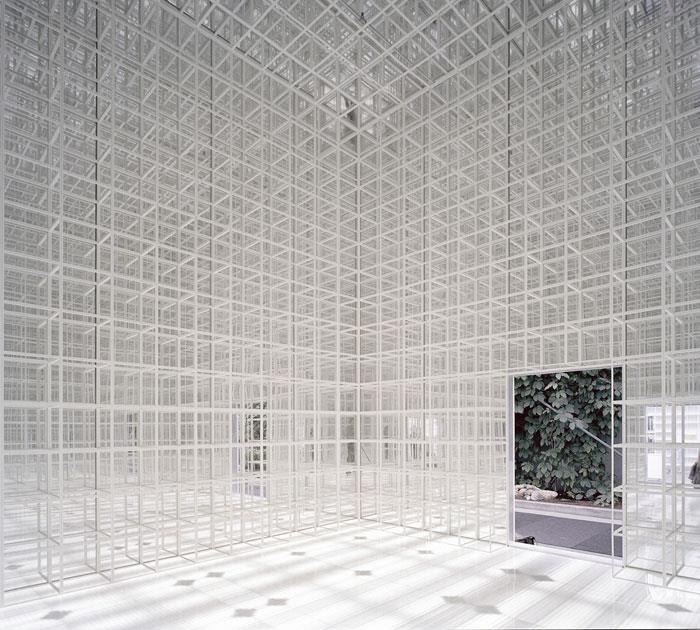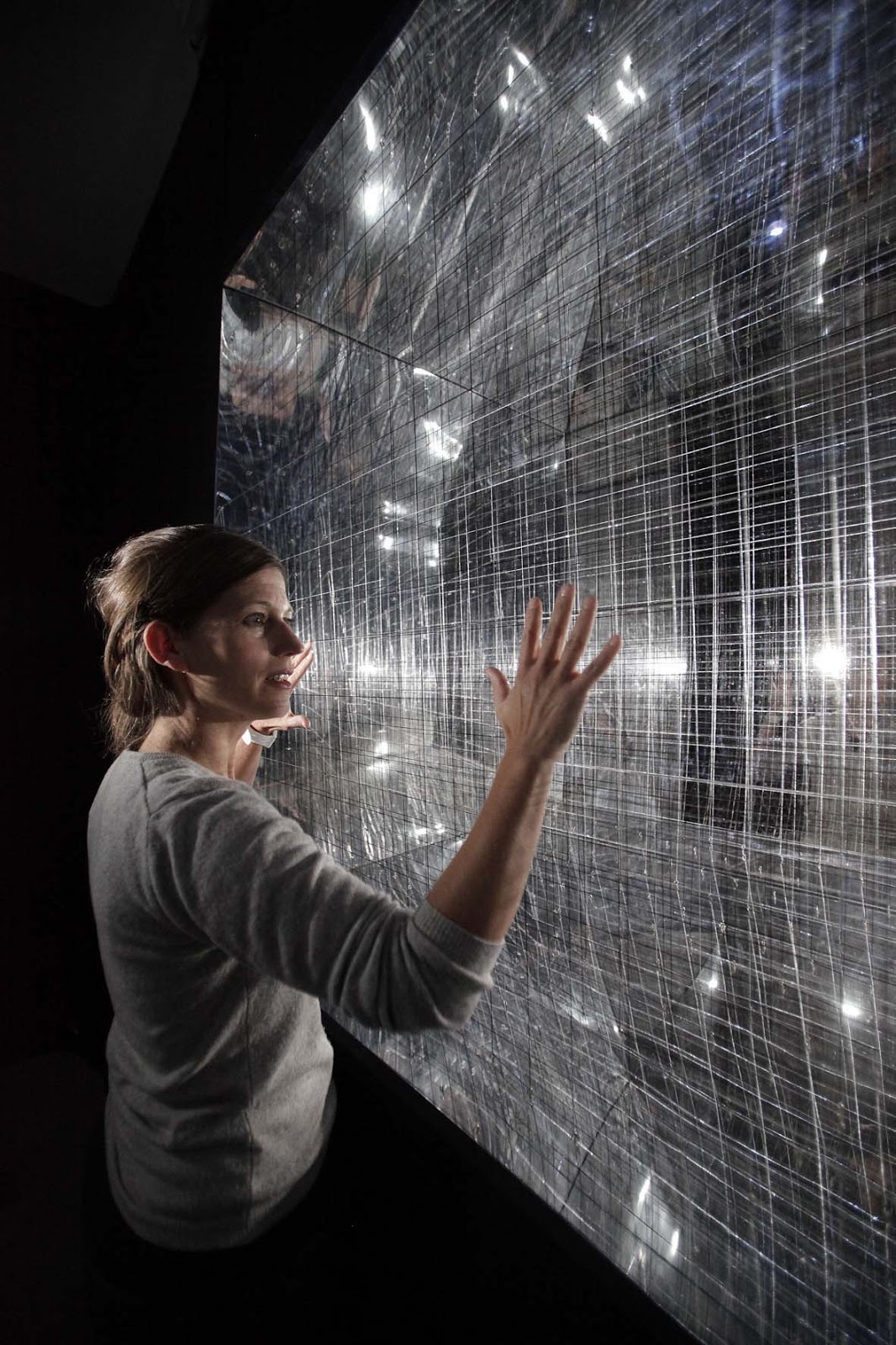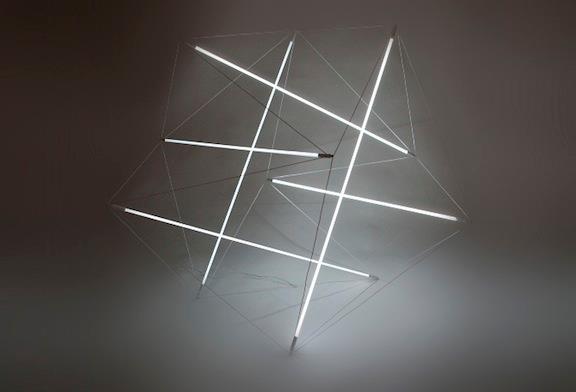


Anthony Gormley
MATRIX
“This materialised grid system gives a great sense of disorientation. As you are drawn by these push-pull perspectives and as you walk around the piece, the impossibility of reconciling foreground, mid-ground and background and the absence of any figure within this ground undermine any certainty of the stability of architecture itself.” Anthony Gormley

Christoph De Boeck
Staalhemel
The intimate topography of the brain is laid out across a grid of 80 steel ceiling tiles as a spatialized form of tapping. The visitor can experience the dynamics of his cognitive self by fitting a wireless EEG interface on his head, that allows him to walk under the acoustic representation of his own brain waves.The accumulating resonances of impacted steel sheets generates penetrating overtones. The spatial distribution of impact and the overlapping of reverberations create a very physical soundspace to house an intangible stream of consciousness.‘Staalhemel’ (‘steel sky’, 2009) articulates the contradictory relationship we entertain with our own nervous system. Neurological feedback makes that the cognitive focus is repeatedly interrupted by the representation of this focus. Concentrated thinking attempts to portray itself in a space that is reshaped by thinking itself nearly every split second.

Madi Boyd
the Point of Perception
Produced in collaboration with neuroscientists at UCL, Beau Lotto and Mark Lythgoe, this work is art and science; we intend it as an experiment in the gallery. It manifests as an immersive environment consisting of a ‘screen’ which is a large gridded space of uncertainty and projected film.The project came about after I undertook a period of research of the human visual system and neuroesthetics and set up a collaboration with Professor Mark Lythgoe and Dr Beau Lotto at UCL.

Ralf Baecker
Putting The Pieces Back Together Again
The kinetic installation “Putting the Pieces Back Together Again” is a complex system with self-organizing and emergent behaviour, at the same time it is an artistic inquiry and meditation on contemporary scientific methodology. The installation investigates non-hierarchical communication and collective behaviour by implementing such a system physically through many electro-mechanical actors.
The Installation consists of 1250 stepper motors arranged in a two dimensional grid of two by two meters. Each motor is equipped with a pointer made from white acrylic glass. The radii of the pointers are chosen to intersect with the pointers of its neighbours. All motors are excited with the same alternating current that let them move initially in a random direction. Each actor is at the same time sensing its environment. In the event of a collision the pointers reverse their turning direction. This is achieved through a custom motor control circuit. Through the interplay of many entities a complex behaviour emerges on the surface of the installation. By manipulating the signals during runtime the system will form spontaneous pattern on its surface. It seems like they are negotiating it’s position with nearby actors. By this the system is showing behaviour of self-organization. The installation drifts through various activation levels during its run time by this it constantly evolves new formations and constellations (crystallization).

RADIAL AND BLAUS
MID AND PLAYMODES
radial and blaus
‘radial’ and ‘blaus’ are two interactive lighting installations, both a result of the collaboration between catalonia-based digital research collectives MID (media interactive design) and playmodes. ‘blaus’ introduces the abstract realm of three dimensional geometry through the mediums of audio and illumination – this could manifest as a cube or a blossoming flower, a grid or a jellyfish, a mutant framework of reflecting lights which submerge the audience into a multi-faceted universe, driven by hidden forces of the architecture. ‘blaus’ is an immersive space where audio-visual elements relate
intimately to impact on the visitor. the process led the designers to build most of the software and hardware elements themselves, by means of algorithm design, digital fabrication techniques and craft handwork. on the hardware side, the use of open source technologies, such as arduino, allowed us to create a flexible electronic system easily addressable by opensound – control data. ‘duration open source software by
james george was used in order to independently control, compose, and play a full score for the laser diodes, servomotors, lights and music.on the sound design side, all music and sound effects are made through the use of audio programming environments such as predate and reactor.
custom digital instruments are made in order to exactly match the resonant frequency of the space and its harmonics.
‘blaus’ is an immersive space where audio-visual elements relate intimately to impact on the visitor.

GRAHAM THOMPSON
Synthetic Sustainability
Graham Thompson tries to redefine urbanism by proposing urban synthetic hyper structures that sustainably manage urban density, personal space, and communal areas. A fresh graduate from the Bartlett School of Architecture the proposal features undulated surface towers, farming zones, clean energy generating systems, green transportation facilities and recreational areas. The sustainable structure would come along a water depository within barren undeveloped land ready for zoning. The undulating bionic towers of the project would act as urban farming zones that promote local flora and fauna managed by the inhabitants for sustainable growth. These agricultural zones have individual harvesting grids with water filtration and nutrient monitoring systems. The tower canopies are layered with solar recharging zones to harvest solar energy and locally meet power needs. Graham also visualizes eco train stations for green transportation along with green service stations for eco car charging.

MICHAL MACIEJ BARTOSIK TENSEGRITY
lights
The tensegrity space frame light is comprised of a four strut lamp module whose geometry is the derivative of a cube. It affords a stable platonic structure with the ability to orthogonally tessellate in the x,y.z axes without change to its orientation to produce generic architectural elements such as: columns, roofs, walls and beams. Because tensegrity yields a system of structural correlation, moment force is eliminated and makes way for a high strength to weight ratio; as the system’s surface area increases, to a greater extent so too does its rigidity, allowing for generous spans and cantilevers. When arrayed, each consecutive module is pinned to the latter using its lamp connector to fasten to the mid point of an adjacent electrical tendon. The uniform array produces two distinct patterns of lamp and lattice. Where the lamps produce a luminous weave that at times resembles an orthogonal grid of offset lines, the lattice generates a sequential pattern of two distinct squares rotated at 45 degrees, one four times the size of the other.